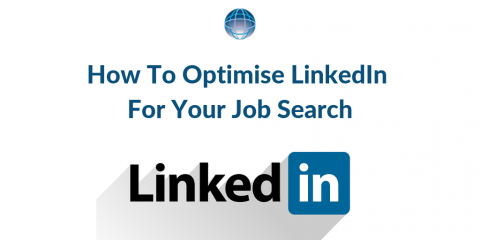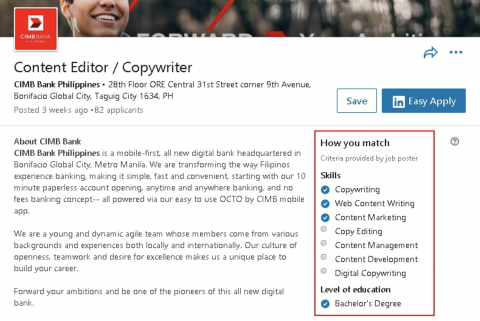Please check the information entered!
- Please check the information entered
A log-in email has been sent to your email address
Forgot password? Reset password
With 303 million active users as of January 2019 [source*] and a strong focus on professional networking and recruitment, LinkedIn is an incredibly powerful tool if you are searching for a new job or opportunity.
But with plenty of competition and more new profiles being added all the time, how can you ensure you have the best chance of standing out from the crowd when you are searching for a new job?
Here are 10 ways to get your profile optimised and heading in the right direction:
Before you can update and optimise your LinkedIn profile so that it’s working for you in your search for the perfect role, you need to define what that perfect role actually is. After all, how can you optimise your profile if you’re not sure exactly what it is you are looking for?
The bottom line is it would be a waste of everyone’s time (yours, recruiters and potential employers) if your profile intimates that you are keen on securing a certain position when, in fact, your heart is really set on something else.

The next step on your journey to LinkedIn job search success is to ensure you have an appropriate profile picture. Now we’ve italicised the word ‘appropriate’ in the last sentence because it is important. That’s because you shouldn’t view your LinkedIn profile picture in the same way you do, say, your Facebook one.
Think of your LinkedIn profile as your first opportunity to make a good impression in the eyes of recruiters and potential employers. Is that picture of you sunbathing in Thailand last year or the one of you with a stein of beer at Oktoberfest really appropriate when you’re job hunting?
We’re not saying that you have to go full-on passport serious, but looking professional and presentable is a must.
With your dream job defined and your best mugshot in place, it’s time to start optimising your LinkedIn profile so that it gets you found by recruiters and organisations with roles to fill. The first component of your LinkedIn profile to help achieve this is your headline.
Your LinkedIn headline is actually trickier to get right than you may think – especially when you are actively searching for jobs. Our advice here is to think like a recruiter/employer and anticipate what they might be searching for on Linked In.
If you want to be considered for a role as a junior digital marketing specialist, make sure your headline reflects that. For example, there is no reason why you can’t put something like: “Seeking position as a junior digital marketing specialist” as your headline.
Remember, recruiters and potential employers will be searching for certain job titles on LinkedIn. To be in with a chance of being considered, your profile needs to appear.
While it is your LinkedIn headline that helps you get found, it’s your summary that is your opportunity to tell recruiters and potential employers why they should hire you.
Recruiters and potential employers are inevitably busy and we will soon overlook your profile if what’s written in your summary doesn’t grab their attention.
Spell out exactly why you are a perfect fit for the role you’re targeting and outline some of your biggest strengths.
A great way to come up with some perfect summary content is to grab a bunch of job descriptions for roles that interest you and look for commonalities between them. You can then write your summary to specifically target these kinds of roles, including appropriate keywords where they naturally fit (never be spammy).
Any experience you’ve got should be included on your LinkedIn profile for recruiters and potential employers to see.
Start with your experience that is most relevant for the role you are actively trying to secure. After all, this is what a recruiter or potential employer will be most interested in. Then, look how you can polish your other experience so that it complements your job search.
For example, even a previous role of yours that might seem irrelevant, may have seen you utilising some skills that can be applied for the role you wish to secure. Highlight these skills above any others.
LinkedIn has a really powerful tool for helping you ascertain what skills recruiters and potential employers are looking for. It’s the How You Match feature**.
Simply go onto any job posting and you will automatically see how the skills listed on your LinkedIn profile match the ones being sought by the advertiser.
Look at this example of a copywriter job posting:

As you can see the candidate has some (not all) of the skills required, as well as the level of education the job poster is looking for. The candidate could now review the skills required and update their profile – providing they do indeed possess said skills – to stand a better chance of securing an interview.
Again, grab a bunch of job listings and see what skills are being sought. You can then update your LinkedIn profile accordingly. But never list skills you do not have.
Social proof (things like testimonials, reviews, case studies, media coverage, etc.) is extremely influential when companies are selling their products and services. The same goes when you are searching for jobs. You are effectively selling your skills and experience, which is why social proof in the form of endorsements (for skills) and general recommendations on LinkedIn can be very powerful.
The reasons that endorsements and recommendations are so effective when you are searching for a job is because they help prove many of the things you have said in your summary and listed in your experience section. With endorsements and recommendations, it’s no longer just you saying how good you are, but other people backing those claims up.
In the same way that social proof helps sell products and services, endorsements and recommendations help cast you in a positive light for recruiters and potential employers. Ask colleagues (past and present), professional acquaintances and any other relevant parties if they would be so kind as to provide you with a recommendation and some endorsements of your skills.
Like most social networks, the more you put into LinkedIn, the more rewards you’ll reap. Sitting back quietly and expecting recruiter and potential employers to contact you isn’t the way to get noticed. Instead, actively search for groups that are relevant to your skills/experience and get involved in the conversations that are occurring in them.
Your chances of being seen and remembered by a recruiter or potential employer are significantly increased if you are active in relevant LinkedIn groups and providing real value to the other members.
Remember, you are only one profile view away from potentially securing your next dream role.
First impressions (even online) count. Don’t make a bad one by having a LinkedIn profile that’s littered with spelling and grammar errors.
While LinkedIn does have its own built-in spell checker, you can never be too careful. An easy way to double-check what you’ve written is to copy and paste it into a program like Microsoft Word. Moreover, if you really want to benefit from a summary that shines, consider hiring a professional writer to produce it for you.
At the very least you should run what you’ve written by a friend or colleague so you can gauge their opinion.
Last but certainly not least is a LinkedIn feature that some people overlook. It’s basically a way of telling recruiters and potential employers that you are actively seeking new roles/opportunities, and are happy for your details to be shared with them.
Navigate to https://www.linkedin.com/psettings/jobs/profile-shared-with-recruiter and make sure the toggle is set to ‘Yes’.
Be warned, though, that as the warning on the above page states, LinkedIn cannot guarantee that your current company won’t see that you’re open to discussing new opportunities. So, if you are currently employed and your employer does not know that you are searching for a new job, it’s probably best to set this option to ‘No’.
* Statista: https://www.statista.com/statistics/272014/global-social-networks-ranked-by-number-of-users/
** https://blog.linkedin.com/2018/may/14/introducing-how-you-match-on-linkedin-jobs